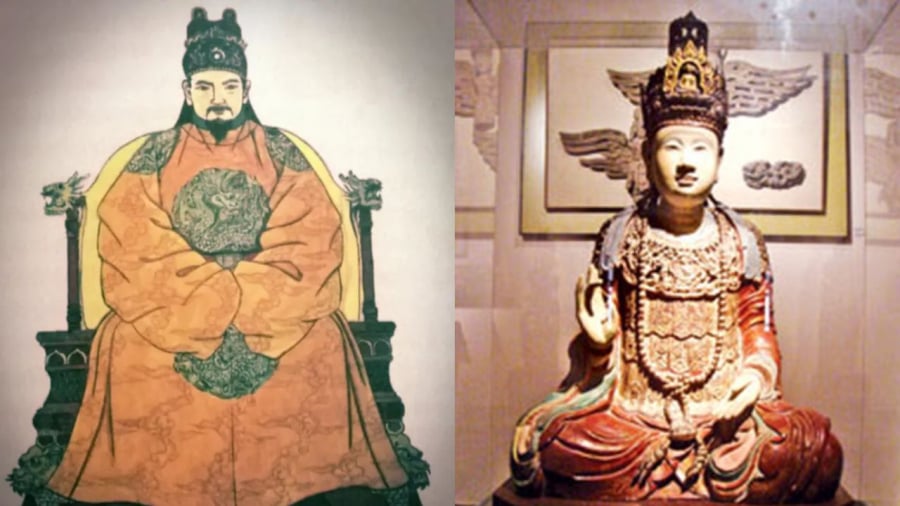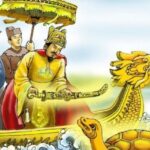In the history of Vietnamese feudalism, it is rare to find a monarch who has been crowned twice. Yet, Lê Thần Tông, the 18th king of the Later Lê Dynasty, is one such unique ruler. His life is marked not only by his two reigns but also by profound personal losses and a most unusual marriage unprecedented in Vietnamese history.
Twice Crowned, But Why?
King Lê Thần Tông, born Lê Duy Kỳ on November 19, 1607, first ascended the throne in 1619 at the tender age of 12, taking the reign name of Thần Tông. He ruled for 24 years until 1643 when he voluntarily abdicated in favor of his son, Lê Duy Hựu (later King Lê Chân Tông), stepping down to become the Retired Emperor.

However, his respite from ruling was short-lived. In 1649, King Chân Tông passed away at a young age without a mature heir. Lê Duy Kỳ had no choice but to resume the throne at the age of 42, ruling for another 13 years. Thus, he became the only king in the history of the Lê Dynasty to reign twice, accumulating an impressive yet tumultuous 37 years as monarch.
A Father’s Perpetual Loss Behind the Throne
Following the death of Lê Thần Tông in 1662, the crown passed to his son, Lê Duy Vũ, also known as King Lê Huyền Tông. But fate seemed unkind to this royal lineage. King Huyền Tông’s reign was cut short after just 9 years when he died at the young age of 18. Next in line was Lê Duy Hợi (King Gia Tông), another son of Lê Thần Tông, who ascended the throne but ruled for only 4 years before succumbing to a severe illness.
It was the youngest son, Lê Duy Hợp, or King Lê Hy Tông, who finally enjoyed a longer reign, ruling for 30 years. Thus, of Lê Thần Tông’s four sons who successively inherited the throne, three perished prematurely, leaving only one to rule for an extended period. This was not just a matter of succession but also a continuous cycle of grief for a father who had to bear the loss of his children one after another.
A Singularly Strange Marriage in Vietnamese History
Beyond his political career, King Lê Thần Tông is also remembered for his unusual marriage, a rarity according to the “Đại Việt sử ký toàn thư.” He wedded Trịnh Thị Ngọc Trúc, daughter of Trịnh Tráng, as his empress. Notably, before marrying the king, Ms. Ngọc Trúc had been married to the king’s uncle, Lê Trụ, with whom she had four children. When Lê Trụ was imprisoned, her father arranged for her to marry the king to strengthen the political alliance between the two families.
At the time of this marriage, the king was only 23, while Ms. Ngọc Trúc was already 36. Many courtiers advised against this union, but the king simply replied, “It will be over soon; it’s just a temporary arrangement.” Following the wedding, persistent heavy rain fell for many days, which some interpreted as an ominous sign. Despite this, Ms. Ngọc Trúc became one of the king’s most respected wives and the only one bestowed with the title of Empress.
In addition to the empress, the king had five other wives, four of whom were foreigners: a Mường woman, a Siamese (now Thai), a Han Chinese, and a Laotian. Most notably, one of his wives was a Westerner, Ms. Orona from the Netherlands. She is the only known Western woman to be officially recognized as a concubine of a Vietnamese king during the feudal period. Ms. Orona accompanied a Dutch trading delegation to Thăng Long in 1630 and subsequently remained as a consort at her father’s request.
Six Wives, United in Harmony
Remarkably, all six of King Lê Thần Tông’s wives lived in harmony—a rare occurrence in feudal times. According to legend, after the king’s death, the six wives pooled their money to commission six statues of themselves at Mật Sơn Temple in Thanh Hóa. Ms. Trịnh Thị Ngọc Trúc’s statue was seated on a lotus pedestal, while the others wore crowns and were depicted in meditation poses. Each statue bore distinct facial expressions, attire, and postures, reflecting the diverse cultural backgrounds of the wives.
The life of King Lê Thần Tông is a unique chapter in Vietnamese history. He was the only king in the Lê Dynasty to reign twice, and he endured the heartache of losing his children one by one. His unusual marriage and the presence of a Western concubine in his harem further set him apart. Behind the facade of power and glory lay silent sorrows and immeasurable losses.
The Ultimate Guide to Vietnam’s History: 100+ Intriguing Quiz Questions and Answers
Introducing an exciting collection of over 100 historical riddles, specifically designed to engage young minds and spark their curiosity about Vietnam’s rich heritage. These carefully crafted riddles offer a fun and interactive way for children to explore the country’s past, from legendary figures to significant events that have shaped the nation’s identity. It’s an educational journey through time, where each riddle unveils a fascinating tale, fostering a deeper connection to Vietnam’s proud traditions and a stronger foundation for the future.



































